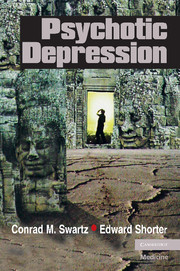Book contents
- Frontmatter
- Contents
- Preface
- Acknowledgments
- Chapter 1 Introduction
- Chapter 2 History of Psychotic Depression
- Chapter 3 Diagnosis in Psychotic Depression
- Chapter 4 Patients' Experience of Illness
- Chapter 5 Treatment in Historical Perspective
- Chapter 6 Treatment: Pitfalls and Pathways
- Chapter 7 Treatment: ECT, Medications, and More
- Chapter 8 Treatment by Type of Psychotic Depression
- Appendix 1 Summary Guide to Psychiatric Concepts
- Appendix 2 Summary Guide to Psychotropic Medication and Treatment
- References
- Index
Appendix 2 - Summary Guide to Psychotropic Medication and Treatment
Published online by Cambridge University Press: 10 September 2009
- Frontmatter
- Contents
- Preface
- Acknowledgments
- Chapter 1 Introduction
- Chapter 2 History of Psychotic Depression
- Chapter 3 Diagnosis in Psychotic Depression
- Chapter 4 Patients' Experience of Illness
- Chapter 5 Treatment in Historical Perspective
- Chapter 6 Treatment: Pitfalls and Pathways
- Chapter 7 Treatment: ECT, Medications, and More
- Chapter 8 Treatment by Type of Psychotic Depression
- Appendix 1 Summary Guide to Psychiatric Concepts
- Appendix 2 Summary Guide to Psychotropic Medication and Treatment
- References
- Index
Summary
This is a sketch of psychotropic drugs used in treating or managing psychotic depression. We list the generic name of the drug first. Using only the generic name directs focus to the patient and away from drug advertising. It prevents the costly suggestion associated with mentioning the brand name. Some drugs identified below as costly should soon cost less, as generics become available.
Antipsychotic tranquilizers
The drug type “antipsychotic” is a misnomer. All antipsychotics powerfully affect thought processes in everyone who takes them. They do not make thoughts normal and they are not specifically antipsychotic. Rather, they generally decrease the complexity and amount of thinking. Most patients discontinue their antipsychotic drug, probably because it decreases feelings of pleasure in life experience and reward in accomplishment overall, including for taking medication properly. Other side effects vary; for example, some antipsychotics cause grogginess but others do not. Drugs that are still on patent typically cost several times as much as generics.
The original antipsychotics were called neuroleptics (the commonest class of which were phenothiazines). These drugs block the effects of the neurotransmitter dopamine, causing dopamine deficiency. Dopamine blockade decreases outflow of nerve cell activity from the prefrontal lobes of the brain, analogous to a faucet decreasing water flow. The prefrontal lobes house the complex thinking of the human brain. Dopamine deficiency is part of Parkinson's disease.
- Type
- Chapter
- Information
- Psychotic Depression , pp. 269 - 282Publisher: Cambridge University PressPrint publication year: 2007

